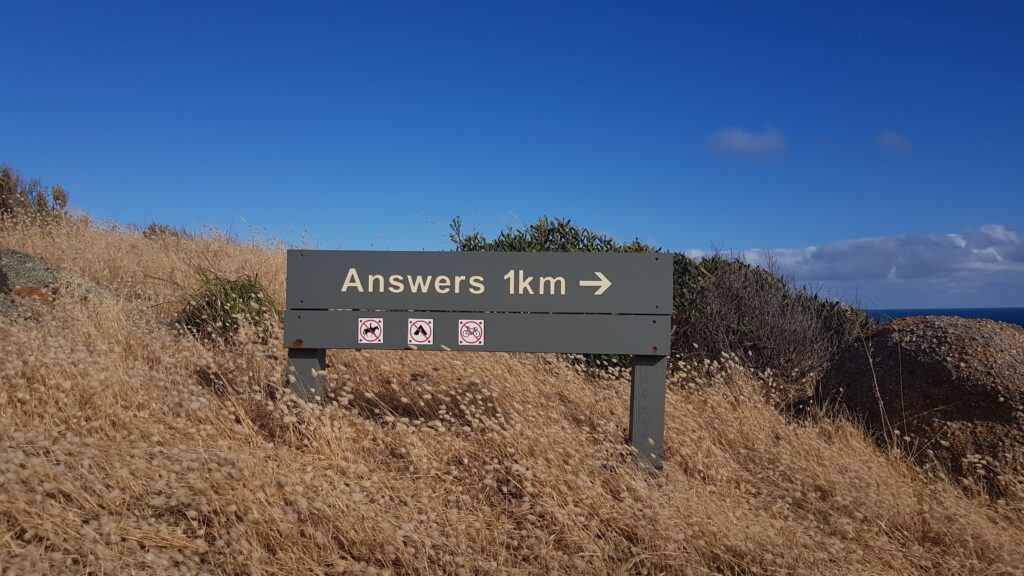
Asking Effective Questions

You may want to ask questions of your class during lessons in order to:
- Encourage student participation and recall
- Stimulate students’ deep thinking
- Check in with students
This post provides some ideas and examples for how to form and deliver questions to achieve each of these goals.
1. Encourage Participation and Recall
Students are less likely to answer your questions if they find them confusing, vague, or unrelatable. Students are more likely to speak up when the questions are understandable, specific, and relatable. Here are some general tips for forming questions that students will want to answer in class, based on advice from Powers (2020).
- Ask one question at a time (multiple questions can be confusing)
- Ask short questions (long questions can be hard to follow)
- Ask specific questions you want to know the answers to (if you already know the answer students may wait to hear your “correct” answer)
- Use what and how questions (why questions can feel pushy)
- Don’t hide the answer in the question (either the question may be too easy or it can discourage authentic responses from students)
Review a “This or That” H5P activity with examples that demonstrate these ideas: Which Question Do You Prefer to Answer?.
LOTS Questions for Recall
Students are more likely to answer recall questions that allow them to share what they already know and can do. Recall questions are lower order thinking skills (LOTS), according to Bloom’s taxonomy of thinking skills (Armstrong, 2010). LOTS questions ask students to reproduce knowledge and skills. For instance, they can have students:
- Name
- Identify
- List
- Classify
- Compare
- Differentiate
LOTS questions can help prepare brains to think more deeply about content and in more complex ways.
2. Stimulate Deep Thinking

According to Bloom’s taxonomy, higher Order Thinking Skill (HOTS) questions ask students to produce knowledge and skills. They help students to dig deeper and think longer about course content. For example, they can have students:
- Analyze
- Diagnose
- Critique
- Judge
- Evaluate
- Predict
- Create
HOTS questions expand on students’ foundational knowledge, helping them synthesize information, reflect on their understanding, and even consider their thinking processes (i.e., metacognition) (Elder & Paul, 2012). Because the ability to answer HOTS questions often relies on accessing foundational knowledge and skills, HOTS questions should be asked after LOTS questions.
See this Spectrum of Effective Questioning job aid that gives examples of LOTS and HOTS questions. Use these different question types incrementally to develop and deepen students’ levels of thinking.
Supporting Students Answering HOTS Questions
Students may struggle with answering HOTS questions in class. Here are some tips that can help students (Waterlook n.d.):
- Be clear about what question you want to ask
- Confirm prior knowledge first
- Anchor questions in personal knowledge
- Lead students in the right direction
- Give students possible answers
- Give students time to think or write
- Provide opportunities for discussion, such as a think-pair-share
- Explain why answering the HOTS question matters
If students cannot answer HOTS questions, you may need to return to asking LOTS questions to confirm that students have sufficient knowledge and thinking skills required to answer HOTS questions.
See this TeachThought article for 28 Critical Thinking Question Stems for Any Content Area.
Asking Questions Across the Lesson
Questions should be interwoven throughout a lesson plan to deepen learning. One way to plan questions for learning is to follow the gradual release of responsibility model (Bogdanovich, 2014). This model (see Fig. 10) has guides students in scaffolded learning activities that gradually allows them to take responsibility for their own learning. See more on the Gradual Release of Responsibility model in the post on Content Chunking.

“I Do” Activity Questions
When you lead lesson activities that explain, instruct, review, or model, you may can concept development questions to students. Most concept development questions are LOTS questions. Examples include (Bogdanovich, 2014):
- In your own words, what is (insert the concept being taught)?
- Which is an example of ________? Why?
- What is the difference between the example and the non-example?
- Give/Draw me an example of ______.
- Match the examples to the definition of ______.
- Which picture/poster shows an example of _______?
“We Do Together” Activity Questions
When you lead students in learning activities that provide a high degree of structure, feedback, and corrections during skill development, you can ask skill development questions. Skill development questions are often LOTS questions. Examples include (Bogdanovich, 2014):
- How did I know how to (insert skill modeled)?
- How did I know that this was the correct answer?
- What did I use to ensure I know the correct answer?
- How did I know how to interpret the answer?
“You Do it Together” Activity Questions
When you provide activities in which students practice together on their own (with limited guidance from you), you can ask guided practice questions. Guided practice questions are often HOTS questions. Examples include (Bogdanovich, 2014):
- How did you know how to __________?
- How did you know that this was the correct answer?
- How did you use to ensure that you knew how to find the _____?
- How did you know how to interpret the answer?
- Which step was most difficult for you? Why?
“You Do it Alone” Activity Questions
When you provide individual activities for students to practice on their own (with minimal guidance from you), you can ask relevance and closure questions. Relevance and closure questions are often HOTS questions. Examples include (Bogdanovich, 2014):
- What did you learn today?
- What was most relevant for you today?
- What do you still need to learn more about?
- How did the lesson meet the lesson’s learning outcomes?
- How might this lesson benefit you in the future?
3. Checking in With Students

At the end of a lesson section, you may wish to “check in” with students by seeing if anyone has any questions or if everyone understands. These check-ins often take the form of questions, such as “Does anyone have a question?” or “Does everyone get it?” or “Am I being clear?”
However, you may find that students are uncomfortable or unwilling to answer these questions, or ask questions of their own. They may not even know what questions to ask (Czt128, 2018).
Alternative Check-In Questions
Here are some alternative prompts to check in with students and seek requests for clarification. In some cases, you may wish to provide alternatives to check-in questions altogether, and instead use “Exit Tickets” or a follow-up class survey.
- We will move on after the class asks me two questions.
- What do you think so far? What are your thoughts?
- How well would you say you understand this concept?
- One of the questions I’m asked a lot is…
- What is one thing someone in the class might be unclear about?
- What else do you need to know?
- What questions do you have?
- Is there a part of the less you would like more clarification?
- What are 3 things you knew, 2 things you learned, 1 question you have (in writing)?
- What is the most important idea that you know now that you didn’t before the class?
- Who wants to meet in a breakout room?
- What is one thing you will be able to apply today?
Final Tips for Delivering Good Questions

No matter what kind of question you are asking, here are some helpful tips for preparing to deliver questions effectively (Waterloo, n.d.):
- Try writing a few different versions of the same question (throw out what you don’t like)
- Pre-write your question on a sticky note (keep handy)
- Read the question with resonance and drama
- Read (or repeat) the question slowly
- Pause after asking the question, giving students time to answer questions
- Avoid interrupting students
- Praise students who give responses
More Information
In the Conestoga Library, read this article on creating good questions for online discussions:
Toledo, C. A. (2006). “Does Your Dog Bite?”: Creating good questions for online discussions. International Journal of Teaching and Learning in Higher Education, 18(2), 150–154.
References
Armstrong, P. (2010). Bloom’s Taxonomy. Vanderbilt University Center for Teaching. https://cft.vanderbilt.edu/guides-sub-pages/blooms-taxonomy/.
Bogdanovich, P. (2014). Higher order questions. https://dataworks-ed.com/blog/2014/10/higher-order-questions/
Czt128 (2018). Alternatives to any questions prompts. ID&T@PHS. https://sites.psu.edu/idtphs/2018/02/26/cats-alternative-to-any-questions-prompt/
Elder, L., & Paul, R. (2012). The thinker’s guide to analytic thinking. Tomales, CA: Foundation for Critical Thinking.
Powers, B. (2020). How to ask better questions.
Waterloo University (n.d.). Question strategies.






